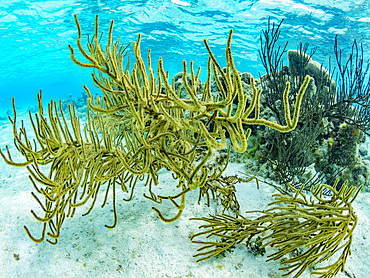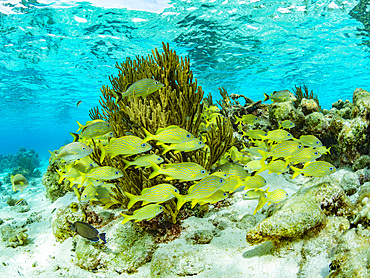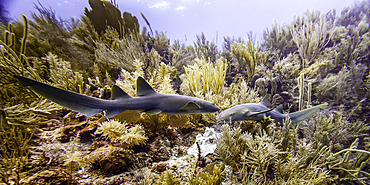Results
4 results found

A beautiful coral reef, dominated by colorful gorgonians, grows along the edge of the Blue Hole in Lighthouse Reef in the Caribbean Sea. This reef is part of the massive Mesoamerican Reef System, the second largest barrier reef on Earth.
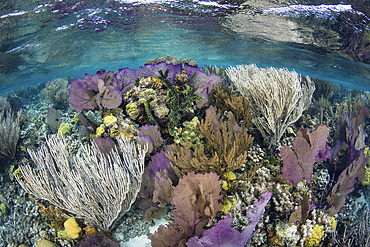
A beautiful coral reef, dominated by colorful gorgonians, grows along the edge of the Blue Hole in Lighthouse Reef in the Caribbean Sea. This reef is part of the massive Mesoamerican Reef System, the second largest barrier reef on Earth.
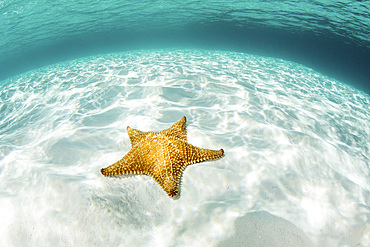
A colorful West Indian starfish, Oreaster reticulatus, crawls over a shallow, sandy seafloor in Turneffe Atoll in the Caribbean Sea. This reef is part of the massive Mesoamerican Reef System, the second largest barrier reef on Earth.

A colorful West Indian starfish, Oreaster reticulatus, crawls over a shallow, sandy seafloor in Turneffe Atoll in the Caribbean Sea. This reef is part of the massive Mesoamerican Reef System, the second largest barrier reef on Earth.
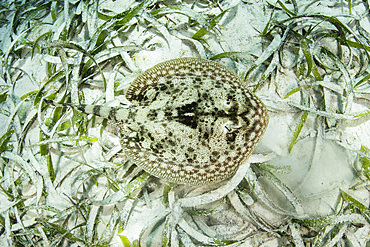
A well-camouflaged yellow stingray, Urobatis jamaicensis, swims over a shallow seagrass meadow growing within Turneffe Atoll's lagoon in the Caribbean Sea. This reef is part of the massive Mesoamerican Reef System, the second largest barrier reef on Earth
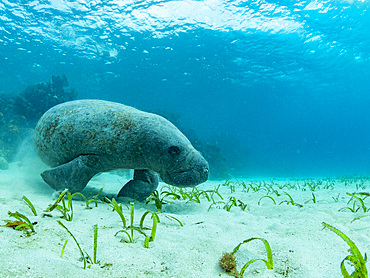
West Indian manatee (Trichechus manatus), on the sand near Caye Caulker, inside the Mesoamerican Barrier Reef, Belize
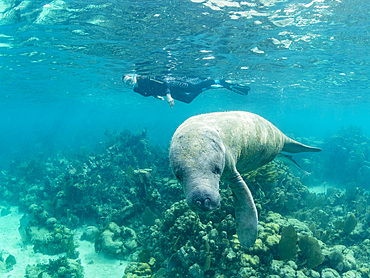
West Indian manatee (Trichechus manatus), with snorkeler near Caye Caulker, inside the Mesoamerican Barrier Reef, Belize
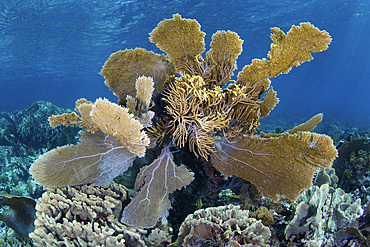
A beautiful coral reef, dominated by colorful gorgonians, grows along the edge of Turneffe Atoll in the Caribbean Sea. This reef is part of the massive Mesoamerican Reef System, the second largest barrier reef on Earth.
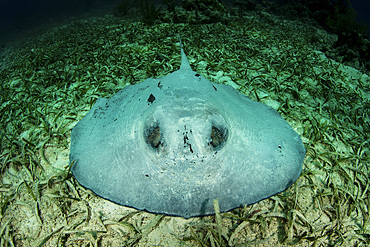
A large roughtail stingray, Dasyatis centroura, lays on the seagrass-covered seafloor of Turneffe Atoll off the coast of Belize. This reef is part of the massive Mesoamerican Reef System in the Caribbean Sea, the second largest barrier reef on Earth.

A large roughtail stingray, Dasyatis centroura, lays on the seagrass-covered seafloor of Turneffe Atoll off the coast of Belize. This reef is part of the massive Mesoamerican Reef System in the Caribbean Sea, the second largest barrier reef on Earth.
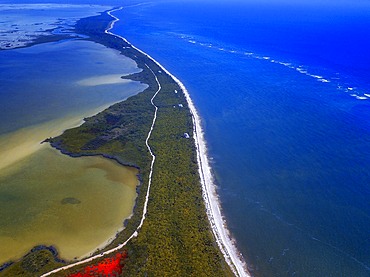
Aerial view of Punta Allen Sian Ka'an Reserve, Yucatan Peninsula, Mexico. Red lagoon near Boca Paila Bridge.
In the language of the Mayan peoples who once inhabited this region, Sian Ka'an means Origin of the Sky. Located on the east coast of the Yucatán peninsula, this biosphere reserve contains tropical forests, mangroves and marshes, as well as a large marine section intersected by a barrier reef. It provides a habitat for a remarkably rich flora and a fauna comprising more than 300 species of birds, as well as a large number of the region's characteristic terrestrial vertebrates, which cohabit in the diverse environment formed by its complex hydrological system.
Along its roughly 120 kilometres of coastline, the property covers over 400,000 hectares of land ranging from sea level to only ten m.a.s.l. The property boasts diverse tropical forests, palm savannah, one of the most pristine wetlands in the region, lagoons, extensive mangrove stands, as well as sandy beaches and dunes. The 120,000 hectares of marine area protect a valuable part of the Mesoamerican Barrier Reef and seagrass beds in the shallow bays. The lush green of the forests and the many shades of blue of the lagoons and the Caribbean Sea under a wide sky offer fascinating visual impressions.

Aerial view of Punta Allen Sian Ka'an Reserve, Yucatan Peninsula, Mexico. Red lagoon near Boca Paila Bridge.
In the language of the Mayan peoples who once inhabited this region, Sian Ka'an means Origin of the Sky. Located on the east coast of the Yucatán peninsula, this biosphere reserve contains tropical forests, mangroves and marshes, as well as a large marine section intersected by a barrier reef. It provides a habitat for a remarkably rich flora and a fauna comprising more than 300 species of birds, as well as a large number of the region's characteristic terrestrial vertebrates, which cohabit in the diverse environment formed by its complex hydrological system.
Along its roughly 120 kilometres of coastline, the property covers over 400,000 hectares of land ranging from sea level to only ten m.a.s.l. The property boasts diverse tropical forests, palm savannah, one of the most pristine wetlands in the region, lagoons, extensive mangrove stands, as well as sandy beaches and dunes. The 120,000 hectares of marine area protect a valuable part of the Mesoamerican Barrier Reef and seagrass beds in the shallow bays. The lush green of the forests and the many shades of blue of the lagoons and the Caribbean Sea under a wide sky offer fascinating visual impressions.
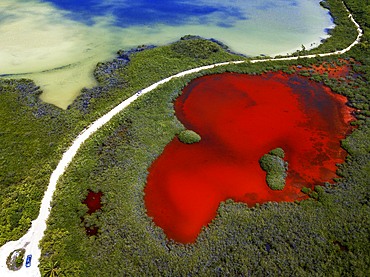
Aerial view of Punta Allen Sian Ka'an Reserve, Yucatan Peninsula, Mexico. Red lagoon near Boca Paila Bridge.
In the language of the Mayan peoples who once inhabited this region, Sian Ka'an means Origin of the Sky. Located on the east coast of the Yucatán peninsula, this biosphere reserve contains tropical forests, mangroves and marshes, as well as a large marine section intersected by a barrier reef. It provides a habitat for a remarkably rich flora and a fauna comprising more than 300 species of birds, as well as a large number of the region's characteristic terrestrial vertebrates, which cohabit in the diverse environment formed by its complex hydrological system.
Along its roughly 120 kilometres of coastline, the property covers over 400,000 hectares of land ranging from sea level to only ten m.a.s.l. The property boasts diverse tropical forests, palm savannah, one of the most pristine wetlands in the region, lagoons, extensive mangrove stands, as well as sandy beaches and dunes. The 120,000 hectares of marine area protect a valuable part of the Mesoamerican Barrier Reef and seagrass beds in the shallow bays. The lush green of the forests and the many shades of blue of the lagoons and the Caribbean Sea under a wide sky offer fascinating visual impressions.
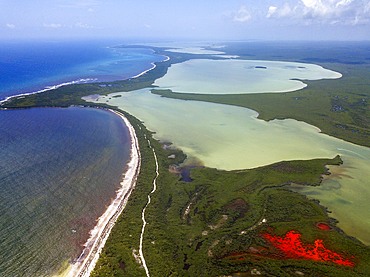
Aerial view of Punta Allen Sian Ka'an Reserve, Yucatan Peninsula, Mexico. Red lagoon near Boca Paila Bridge.
In the language of the Mayan peoples who once inhabited this region, Sian Ka'an means Origin of the Sky. Located on the east coast of the Yucatán peninsula, this biosphere reserve contains tropical forests, mangroves and marshes, as well as a large marine section intersected by a barrier reef. It provides a habitat for a remarkably rich flora and a fauna comprising more than 300 species of birds, as well as a large number of the region's characteristic terrestrial vertebrates, which cohabit in the diverse environment formed by its complex hydrological system.
Along its roughly 120 kilometres of coastline, the property covers over 400,000 hectares of land ranging from sea level to only ten m.a.s.l. The property boasts diverse tropical forests, palm savannah, one of the most pristine wetlands in the region, lagoons, extensive mangrove stands, as well as sandy beaches and dunes. The 120,000 hectares of marine area protect a valuable part of the Mesoamerican Barrier Reef and seagrass beds in the shallow bays. The lush green of the forests and the many shades of blue of the lagoons and the Caribbean Sea under a wide sky offer fascinating visual impressions.

Palms and old pier in Punta Allen Sian Ka'an Reserve, Yucatan Peninsula, Mexico.
In the language of the Mayan peoples who once inhabited this region, Sian Ka'an means Origin of the Sky. Located on the east coast of the Yucatán peninsula, this biosphere reserve contains tropical forests, mangroves and marshes, as well as a large marine section intersected by a barrier reef. It provides a habitat for a remarkably rich flora and a fauna comprising more than 300 species of birds, as well as a large number of the region's characteristic terrestrial vertebrates, which cohabit in the diverse environment formed by its complex hydrological system.
Along its roughly 120 kilometres of coastline, the property covers over 400,000 hectares of land ranging from sea level to only ten m.a.s.l. The property boasts diverse tropical forests, palm savannah, one of the most pristine wetlands in the region, lagoons, extensive mangrove stands, as well as sandy beaches and dunes. The 120,000 hectares of marine area protect a valuable part of the Mesoamerican Barrier Reef and seagrass beds in the shallow bays. The lush green of the forests and the many shades of blue of the lagoons and the Caribbean Sea under a wide sky offer fascinating visual impressions.
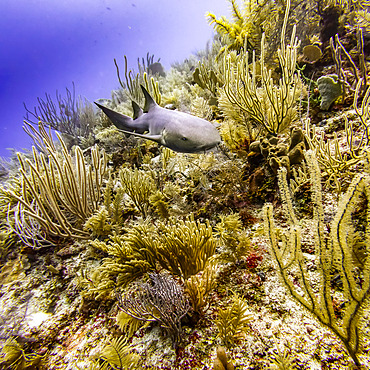
Nurse shark (Ginglymostoma cirratum), viewed while scuba diving at Silk Caye, Placencia Peninsula; Belize
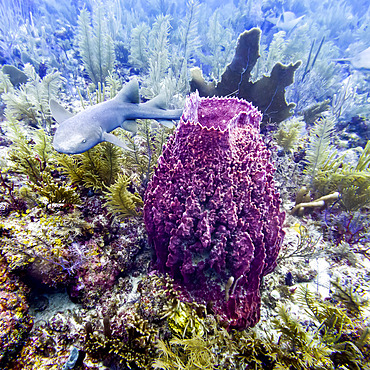
Nurse shark (Ginglymostoma cirratum), viewed while scuba diving at Queens Caye, Placencia Peninsula; Belize
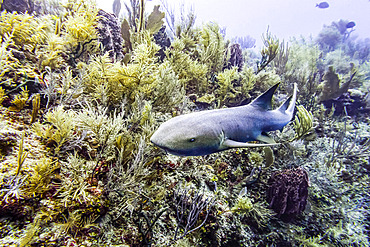
Nurse shark (Ginglymostoma cirratum), viewed while scuba diving at Silk Caye, Placencia Peninsula; Belize
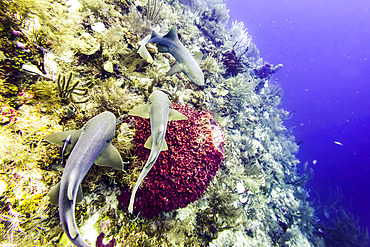
Nurse sharks (Ginglymostoma cirratum), viewed while scuba diving at Silk Caye, Placencia Peninsula; Belize
